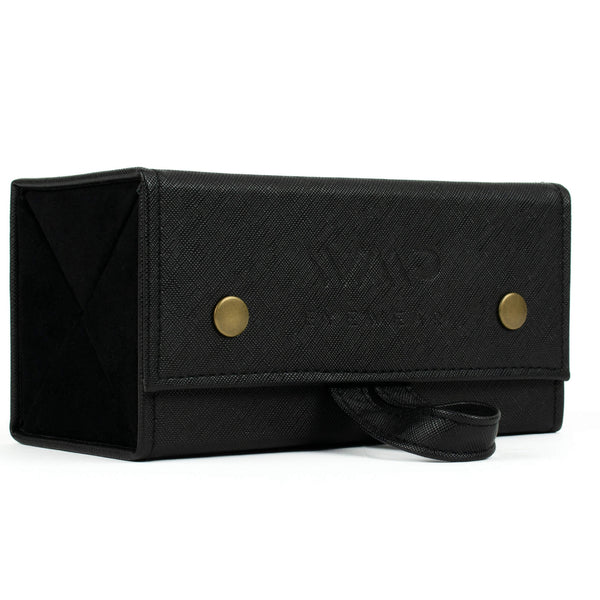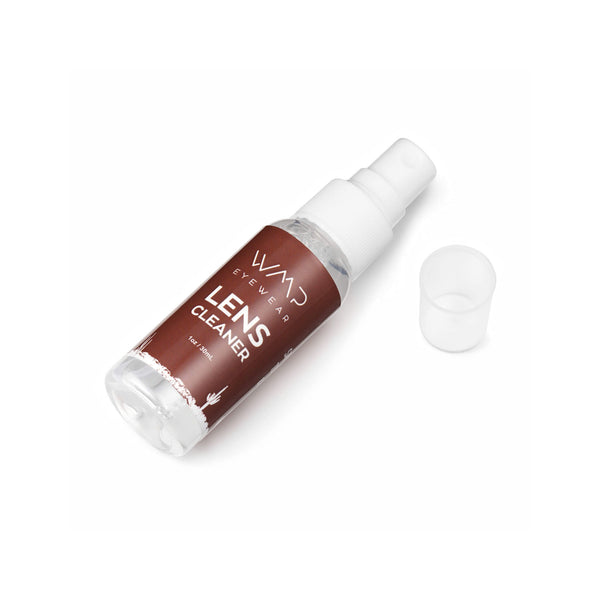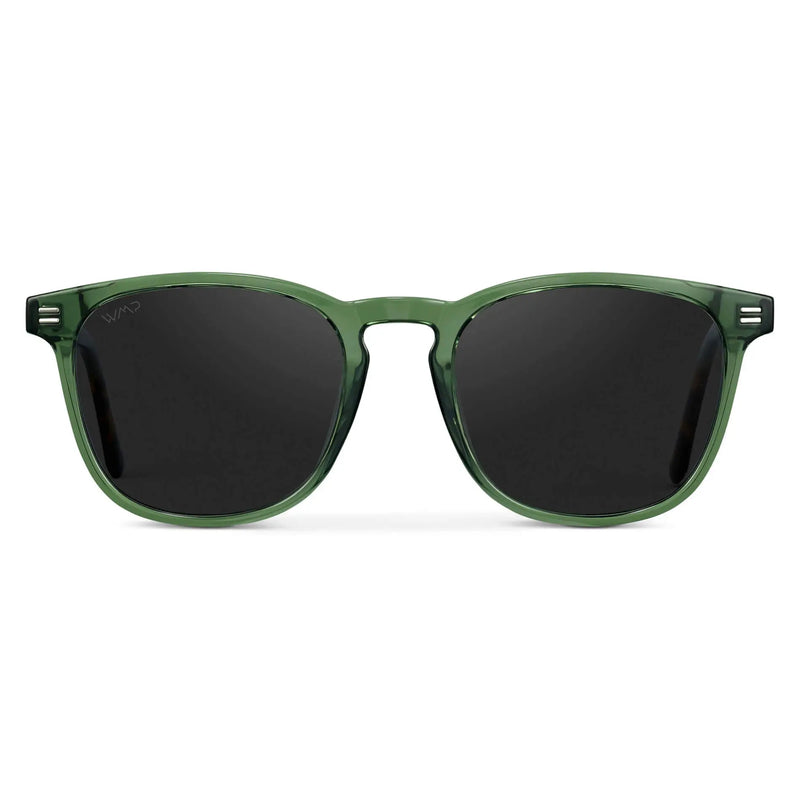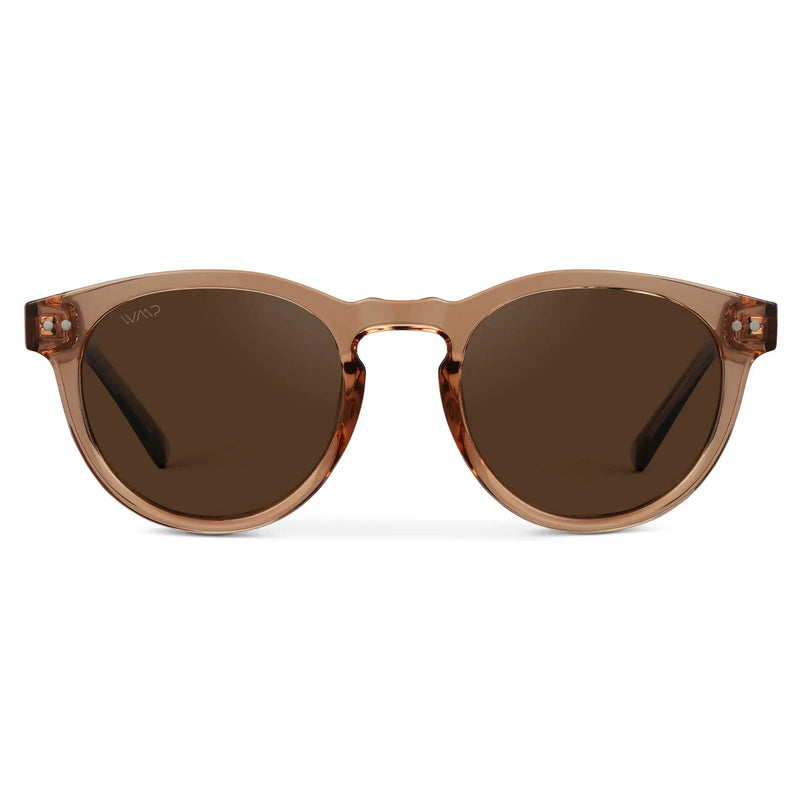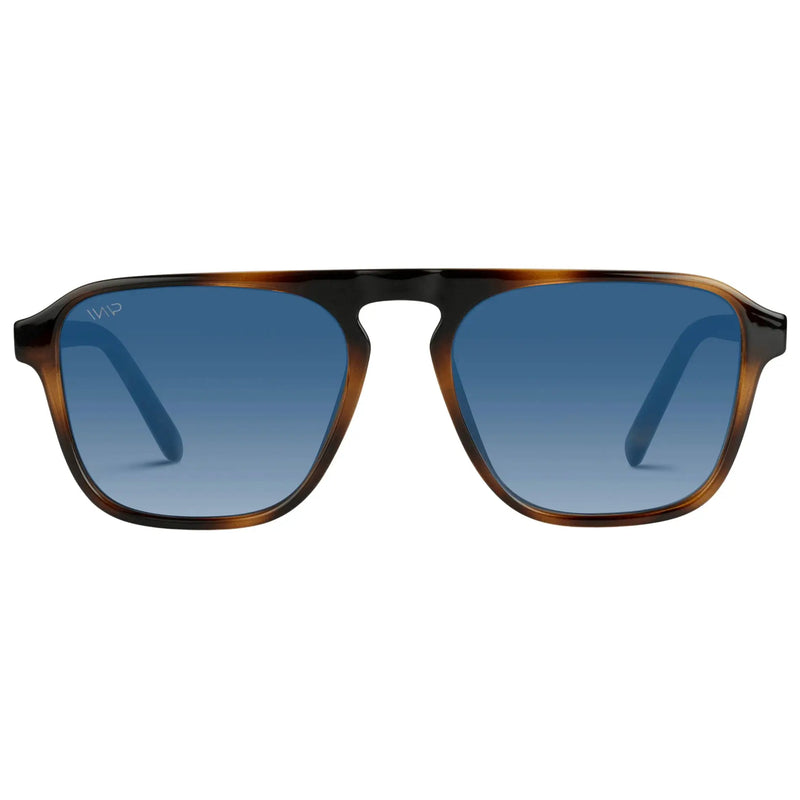Everything You Need to Know About Blue Light Glasses

Blue light blocking glasses are one of today’s hottest trends, but they’re far more than fashion pieces.
If you’re like most Americans, there’s a pretty good chance you spend upwards of 6 hours or more per day with your eyes fixed on a screen. And that’s okay! Our devices help us connect with loved ones, stay productive, keep informed, and relax after a long day—but there’s a dark side to all that screen time.
As it turns out, the blue light emitted from most electronic devices does more than keep us entertained and informed. It may also be causing headaches, damaging our retinas, and disrupting our natural sleep cycles.
The solution? Blue light blocking glasses. Here’s everything you need to know about one of this year’s hottest (and most useful) items.
style: Daisy
What is blue light and why is it a concern?
Sunlight is colorful. We don’t really perceive it with the naked eye, but every ray has components of yellow, green, orange, indigo, and violet. When thrown together, these colors appear white. But different light sources have different colored rays, and not all rays are created equal.
Blue rays, for example, have a shorter wavelength and more energy than other colors. Light that appears to be white (such as the light from our smartphone screens and televisions) tends to have especially high blue components. And those blue components are proven to impact our visual health and sleep schedules.
That said, blue light isn’t all bad and you don’t need to avoid it entirely. In fact, you couldn’t avoid it, even if you wanted to because the sun is by far the largest producer of blue light rays.
The blue light components in sunlight helps keep us awake and alert, which is great if you’re going about your day and you need to stay productive. But blue light becomes a problem when it comes from man-made sources, and unfortunately, there are a lot of them.
In addition to the sun, blue light is also emitted by:
- Many indoor lightbulbs
- Computer monitor screens
- Flat screen LED televisions
- Smart phone screens
- Tablet screens
In other words, pretty much all the devices that we rely on to manage our lives are emitting harmful concentrations of blue light. There’s a pretty good chance that a blue light emitting screen is the last thing you see as you fall asleep and the first thing you look at in the morning. Even the screen you’re reading this on is likely bombarding your eyes with high concentrations of blue light!
Although it’s wrong to say that blue light is 100% bad, excess exposure does have some pretty dire consequences.
Blue light disrupts your natural sleep cycle
We pretend we’re fancy with designer sneakers and high-tech devices, but humans really aren’t that removed from the natural world. Like vulnerable house plants, our bodies are deeply impacted by what kind of light exposure we receive.
Style: Alex
In nature, the blue light emitted from the sun keeps us awake and alert. There’s a reason that the sunlight streaming through your window in the morning helps you get out of bed—that blue light component is like a visual shot of natural espresso. It’s pretty helpful when you’re trying to get through a jam-packed day without dozing off at your desk.
The problem? Our devices also put out high levels of blue light. And we use them all day, every day. We need our devices during the day to stay productive, and we rely on them in the evening to help us unwind. In fact, as many as half of Americans report that scrolling through Twitter or Instagram is a part of their bedtime ritual. Even more report that they can’t sleep unless the TV is on.
Between our TVs, tablets, and smart phones, our bodies just aren’t equipped to handle the sheer volume of blue light that exists today—or the way that it bombards us around the clock. Besides disrupting our sleep cycles by decreasing our overall production of melatonin (your body’s most essential sleep hormone), excessive exposure also leads to:
- Chronic exhaustion
- Insomnia
- Light sleeping
- Tense or anxiety-ridden nightmares
What’s worse is that we’re really only as good as the sleep we’ve gotten the night before. A disrupted sleep pattern doesn’t just mean you’ll be tired the next day, it can also lower your immune system, opening the door for viruses, illnesses, and disease. Even mental health issues like anxiety and depression have been directly connected to sleep patterns.
Blue light harms your eyes
If the threat of potentially losing your vision forever isn't enough to have you second-guessing your blue light exposure, we don’t know what will. On top of disrupting your sleep cycle, blue light components may also cause irreversible damage to your eyes.
Blue light is unique in the sense that it has a shorter wavelength and more highly concentrated energy than other light colors. When blue light hits a molecule called retinal in our eyes, it causes an uncontrollable surge of chemical that could be toxic to the light-sensitive cells in your retinas. According to many experts, those chemicals may eventually cause macular degeneration—a condition which can end in blindness
Of course, not everyone will have such dire consequences—at least not immediately. Before the symptoms of eye damage show up, it’s much more likely you’ll experience some of these pesky short-term effects of blue light exposure:
- Chronic headaches
- Blurry vision
- Strained vision
- Dry, red, irritated eyes
- Migraines
In moderation, blue light is healthy and won’t cause any of these effects. But in today’s world, with blue light bombarding us at every turn, we need a little help in keeping that balance. That’s where blue light blocking glasses come in.
History of Computer Glasses
As with baby formula, computer mice, running shoes, and camera phones, we can thank NASA (the National Aeronautics and Space Administration) for the invention of blue light blocking technology.
While conducting studies for space exploration, NASA’s astronauts struggled with constant bouts of insomnia and chronic exhaustion—something that’s problematic for anyone planning to navigate a state-of-the-art ship through outer space at record-shattering speeds.
In studying the problem, NASA scientists pinned the blame on blue light. Bombarded by these short-wavelength rays, astronauts found it impossible to maintain a regular sleep cycle or get any rest at all.
The solution? Blocking out that disruptive blue light so that astronauts could maintain their natural sleep cycles and not fall asleep at the wheel. The question, of course, was, “How?”
To develop a solution, NASA’s researchers looked toward the natural world for answers, ultimately zeroing in on birds of prey, specifically eagles.
With eyesight that is about 4 to 8 times stronger than ours, eagles can spot prey from a whopping two miles away—and they do so despite the high concentrations of harmful UV rays and blue light that’s present at higher altitudes.
The eagle’s ultra-sharp vision and blue-light resilience is made possible thanks to tiny droplets of oil produced by the bird’s eyes. These oil droplets selectively filter out harmful rays, allowing only certain wavelengths to pass through.
Like a student copying another kid’s homework, NASA researchers learned everything they could about these oil droplets. Then, they designed optic technology which perfectly mimicked them, coining the eyewear as “blue blockers.” These glasses were the very first of their kind to successfully block out harmful rays while still allowing for (and even increasing) vision clarity.
Fast forward several years, and blue light blocking glasses had become especially popular in the gaming community. In the 80s, they became well-liked for their ability to clarify images. Now, with the invention of smart phones and tablets, they’ve become a must-have for anyone who wants to protect their retinas from harmful light components.
How Blue Light Blocking Glasses Work
It may sound like magic, but the science behind blue light blockers is quite simple. Like standard UV filters on regular sunglasses, blue light blockers use a specialized lens film to filter out unwanted light rays, drastically reducing the amount which passes through the lens.
Put simply, blue light filters keep the bad stuff out while letting the good stuff in. That way, you can see perfectly while still guarding your eyes.
Of course, blue light blocking glasses do have a few extra bonuses in addition to relieving eye strain and promoting sleep. They’re also shown to:
- Reduce unwanted glare
- Promote overall visual clarity
- Increase contrast for brighter, sharper visuals
Why wear blue light glasses?
Skeptical about the information you’re hearing about blue light and blue light blocking eyewear? Good! Our moms were right when they told us not to believe everything we read on the internet.
There’s a lot of good information out there that covers blue light and the optic technology used to block it, but there’s also a lot of misinformation floating around.
Fact: Blue light is everywhere
Your electronic devices are a big source of blue light, but they’re not the only ones. Blue light is everywhere. Even if you never looked at another LED screen, your retinas would still be exposed to dangerous levels of blue light just from your surrounding environment.
The reason? Blue light isn’t just emitted by screens—it’s also present in lighting, including:
- Incandescent bulbs
- LED lights
- Halogen bulbs
- Compact fluorescent bulbs (CFB)
Myth: All blue light is bad for you
We associate blue light with our electronic devices, but the biggest source of blue light is actually from the sun. When it occurs naturally, blue light is quite healthy: it boosts your alertness, elevates your mood, and helps keep you awake.
The problem isn’t blue light itself—it’s how much of it our eyes absorb nowadays. Some researchers believe that the average person encounters as much as 90% more blue light than what we’re biologically designed to handle. Put simply, the key is in the balance—and blue light blocking glasses can help keep your exposure at a happy medium.
Fact: Blue light causes sleep deprivation and chronic exhaustion
Excessive exposure to blue light sends mixed signals to your built-in body clock, telling your brain it’s daytime even in the late PM hours. For many, the result is insomnia, difficulty staying asleep, irregular sleep patterns, tense dream states, and/or chronic exhaustion.
According to a study conducted by Harvard, this happens largely because blue light significantly suppresses the production of melatonin, your body’s most essential sleep hormone.
Myth: Digital eyestrain is unpreventable
If your eyes have ever felt dry or sore after time in front of a screen, you’re already familiar with digital eyestrain. Other symptoms include dry eyes, red eyes, blurred vision, headaches, and migraines.
These screen time side effects aren’t fun—but they’re not unpreventable, either. Studies show that wearing blue light blocking eyewear along with practicing the 20-20-20 rule can radically reduce digital eyestrain (or even prevent it entirely!).
Fact: Excessive blue light exposure damages your eyes
Outside of the impacts that overexposure has on your quality of sleep, blue light is also closely linked to accelerated blindness. The pesky day-to-day side effects of screen time (such as eye strain, blurry vision, irritated eyes, and migraines) may be early warning signs of a much bigger problem.
Myth: Blue light blockers are just a trend
Computer glasses have been around since the 80s, but there’s a pretty good chance you’ve only heard about them recently. They’ve exploded in recent years because our time in front of screens has drastically increased, meaning we’re absorbing more blue light than ever before.
As we move forward in the digital age, owning a pair of reputable blue light blockers will become an increasingly essential item. Although blue light blocking eyewear is trendy, it’s far more than just a trend.
How to choose a pair of blue light blocking glasses
Shopping for blue light blockers? The good news is you’ve got plenty of options. WearMe Pro alone currently sells 9 different models, so there’s a fit, design, and size for pretty much every style and face shape.
But before you worry about the overall look and feel, you need to make that pair of cute blue blockers ticks all the boxes on the technical side. Unfortunately, the eyewear market is flooded with cheaply made, ineffective blue-light lenses—some are even complete fakes.
In order to sort the high-quality blue light blockers from the phonies and frauds, know that all blue light blockers should:
- Explicitly state a testing process on the packaging
- Feature grade AAA materials
Once those three bases are covered, picking out your new pair of computer glasses is all about finding a style that fits your personality and face shape. Generally speaking, picking sunglasses that flatter your face shape and selecting blue blockers that look good on you follow the same basic principles:
- Rounded face shapes call for angular or geometric frames that add dimension and definition (such as “cat-eye” or rectangular designs)
- Angular face shapes look best in rounded frames that add softness and balance (like circular frames in chic metal or retro-style tortoiseshell)
At the end of the day, remember that your own comfort and style is king. Face shape guidelines are suggestions, not hard-and-fast rules—so don’t be afraid to push the boundaries and play a little!
Why are some blue light lenses yellow?
A few years back, the only computer glasses on the market were tinted with disgusting yellow lenses. Besides their goofy appearance, they also gave everything you looked at a sickly, yellowish hue. To make matters worse, most models were oversized and chunky—not anything you’d want to be seen wearing in public.
Thankfully, blue light blocking technology has come a pretty long way since those early days. Now, companies like WearMe Pro sell blue light blockers with clear lenses. They look just like standard prescription lenses, meaning you no longer have to sacrifice fashion for functionality.
How Much Do Blue Light Glasses Cost?
Blue light filtering eyewear from luxury brands can set you back as much as $300, but you don’t have to pay top dollar to get a really good pair. In fact, affordable eyewear companies like WearMe Pro offer comparable models for as little as $25.00.
With such huge differences in prices you’re probably wondering what warrants the sky-high price tag on those luxury specs. The bottom line? There really isn’t a reasonable justification.
That several-hundred-dollar margin is attributed entirely to outlandish logo markups. As with sunglasses, high-end eyewear companies charge big bucks for that little branded emblem.
Why? They know they can get away with it—many naive consumers don’t realize they have other, more affordable options. But you don’t have to fall for their costly trap.
For example, WearMe Pros premium blue light blocking line ranges between $14.99 and $24.00 for a wide range of styles and colors. And they don’t sacrifice quality, either. Like the high-end brands, these blue light blockers are lab tested, and manufactured from AAA materials. They’re well-equipped to stop the headaches, optic strain, sleep disruption, and eye damage without breaking the bank.


